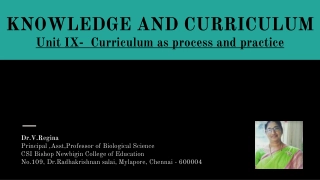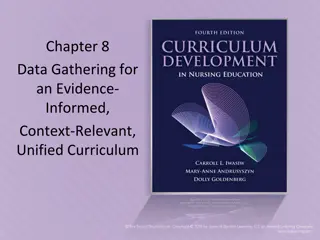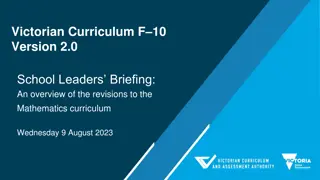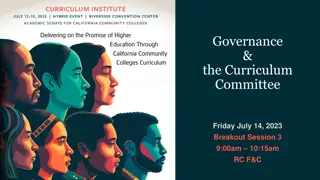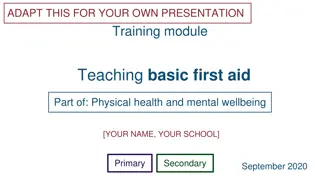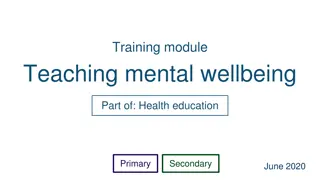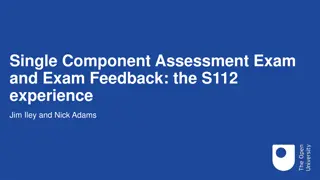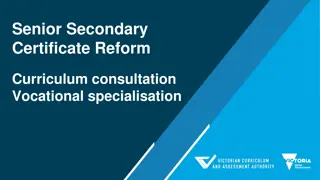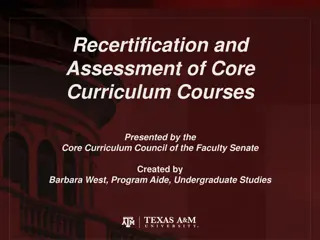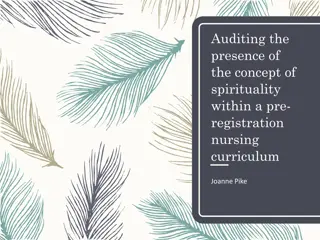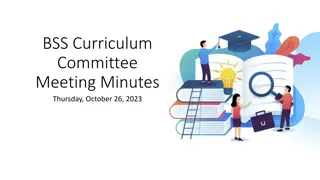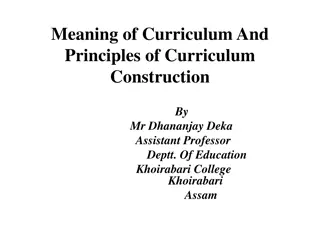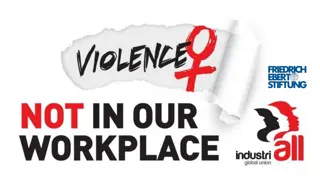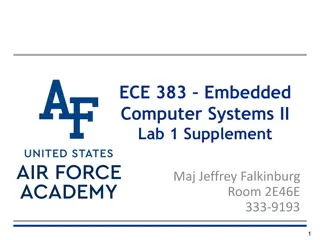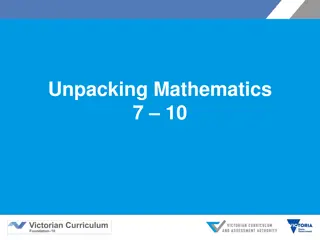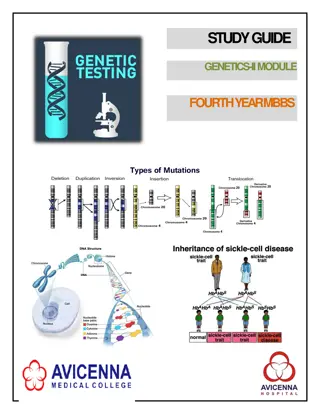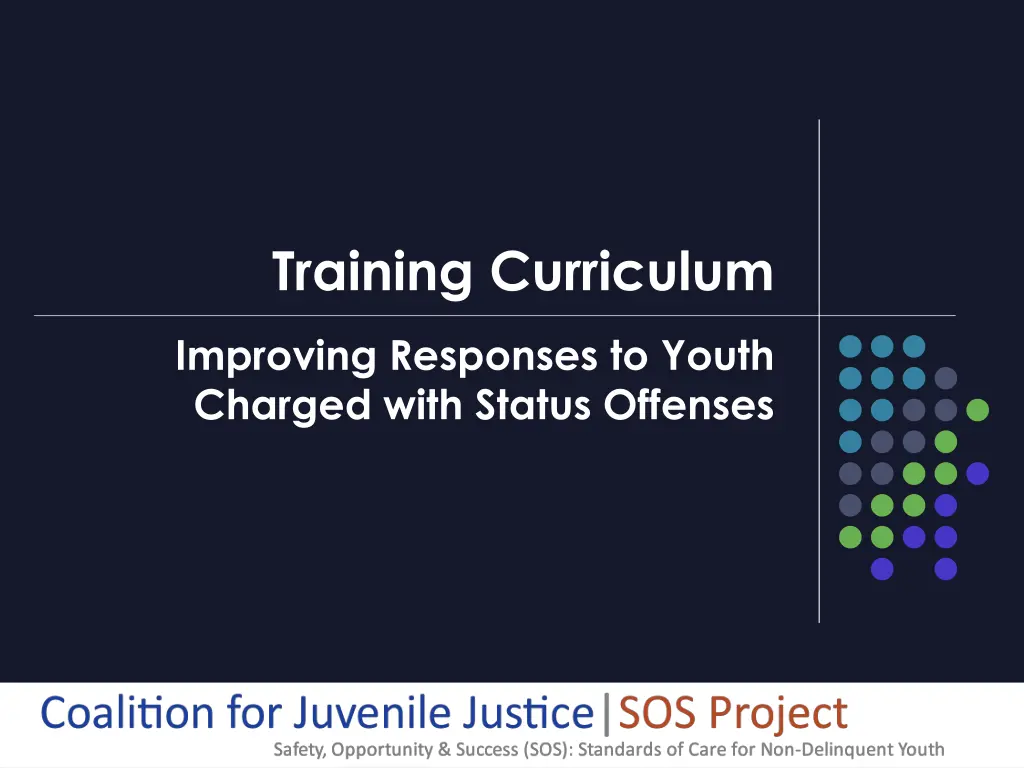
Understanding and Improving Responses to Youth Charged with Status Offenses
Explore the impact of status offense behaviors on youth and learn about efforts to avoid court involvement. Discover why providing voluntary diversion services can lead to better outcomes for young individuals facing status offenses.
Download Presentation

Please find below an Image/Link to download the presentation.
The content on the website is provided AS IS for your information and personal use only. It may not be sold, licensed, or shared on other websites without obtaining consent from the author. If you encounter any issues during the download, it is possible that the publisher has removed the file from their server.
You are allowed to download the files provided on this website for personal or commercial use, subject to the condition that they are used lawfully. All files are the property of their respective owners.
The content on the website is provided AS IS for your information and personal use only. It may not be sold, licensed, or shared on other websites without obtaining consent from the author.
E N D
Presentation Transcript
Training Curriculum Improving Responses to Youth Charged with Status Offenses
Lesson 2 EFFORTS TO AVOID COURT INVOLVEMENT 2
Principle 1 EDUCATION, SOCIAL SERVICE, COMMUNITY-BASED, CHILD WELFARE, RUNAWAY AND HOMELESS YOUTH, MENTAL HEALTH, LAW ENFORCEMENT, AND JUVENILE JUSTICE SYSTEMS 3
Standard 1 Justice systems should aim to resolve all status offense matters through the provision of voluntary diversion services. 4
Background Information Status offense behaviors are low-level offenses that would not be an offense but for the child s age. They are often symptomatic of larger issues the child faces in the home, school, or community and may be less a reflection of the child s risky behavior and more an indication of his or her unmet health, mental health, educational, or family needs. 5
Discussion Points Youth formally processed through the court system may be more likely to re-enter the justice system and experience other negative individual and family outcomes, such as Increased tension between family members Negative educational or mental health outcomes Research has shown that formal justice system processing in and of itself can have a negative impact on youth, increasing the likelihood of future justice system involvement. 6
Discussion Points Entering the formal court system can have many damaging effects on a child and family that may cause them more harm and/or amplify the issues that brought them into the system. Example, in incorrigibility or runaway cases, formal court processing may make the dynamic between parent and child worse and more adversarial. In cases where the parent is an adverse party, court involvement may cause the child to feel resentment towards his or her parents or to feel abandoned. 7
Discussion Points The best outcomes for public safety occur when the least restrictive interventions are offered. They: Better help families resolve conflicts, Increase services to children in need, Cost less, and Ultimately reduce the likelihood of re-entering the status offense or delinquency court system. Stakeholders must take care to prevent information researched in treatment or diversion services from being used against them in any dependency, delinquency, or criminal proceedings. 8
Program Spotlight In New York City, before a petition can be filed in the court, the youth must be referred to the Family Assessment Program for services and assessment, including evidence-based programs. There must be a finding that there is a substantial likelihood additional diversion programs would be of no benefit to the family before the case may proceed to court. Performance-based contracts are used to pay service providers. Out-of-home placements for status offense cases decreased 20% during the program s first two years. Between 2009 and 2012, out-of- home placements decreased 50%. 9
Policy Point State and local authorities should take the position that juvenile court intervention should be avoided or limited in those instances where the young person is alleged to have committed a status offense. Policies in support of this position will eliminate the ability of a family member, school, or other stakeholder to petition status behaviors to the juvenile court. Alternatively, state and local policymakers should establish a continuum of care that is separate and apart from the courts and the juvenile justice system and that relies on non-judicial interventions to respond to status behaviors. 10
Resources Status Offense Reform Center. Notes from the Field: New York City and From Courts to Communities: The Right Response to Truancy, Running Away, and Other Status Offenses. National Juvenile Justice Network. The Truth about Consequences Studies Point towards Sparing Use of Formal Juvenile Justice System Processing and Incarceration. Juvenile Law Center. Protecting Youth from Self-Incrimination when Undergoing Screening, Assessment and Treatment within the Juvenile Justice System. State Training and Technical Assistance Center (webinar). Civil Citations in Juvenile Justice: An Alternative to Punitive Sanctions. 11
Principle 2 FAMILY CIRCUMSTANCES AND UNMET NEEDS 12
Standard 2 Judicial officers should determine the proper course of action by identifying the family circumstances, unmet needs, or other factors that led to contact with the status offense system. 13
Background Information The status offense process is typically not the best way to serve youth and families with unmet needs. Other informal or formal systems, or processes that could address the youth s issues, include: Mental health, Social service or community-based services, Family court (custody), Special education, Child welfare, Emancipation, or Civil commitment proceedings. 14
Background Information While youth charged with status offenses become involved with the justice system because of behaviors that pose little risk to society, they often come from chaotic and even dangerous homes and communities, and may have witnessed or been victims of violence. They or their families may be struggling with trauma or other mental health issues, substance abuse, or other challenges. 15
Discussion Points Youth may also enter the status offense system because of the failure of other systems (e.g., schools, child welfare) to appropriately identify and address their needs. It is essential that youth who have allegedly committed status offenses receive appropriate screening to identify: Physical, mental health (including trauma), and special education needs Substance abuse issues That their physical and emotional safety is ensured 16
Action Steps for Change Juvenile justice, child welfare, and community-based services should use evidence-based or empirically- supported screening tools to triage institutional responses and assessment tools to identify areas in which a youth may need assistance. Youth-serving systems should make reasonable efforts to provide services and supports for children in their own homes and schools before a child is charged with a status offense. 17
Action Steps for Change Professionals should avoid increasing youth and family contact with the system solely or primarily for the purpose of accessing services. As professionals learn more about a particular youth and family, they should consider whether another system or community-based alternative may be better able to respond to the family s or child s needs. When youth are working with more than one system provider or have their case transferred from one system to another, professionals should share and use information effectively, without violating the youth s due process and privacy rights. 18
Resource Spotlight The American Bar Association s Representing Juvenile Status Offenders can be used by any professional who works on status offense matters. Its authors suggest that when deciding whether another formal or informal system or services would be more appropriate, professionals should consider key questions about the child, family, and services available. E.g., What circumstances might the youth be responding or reacting to? What resources/services does the youth need? What is the youth s relationship with her parents? 19
Resources American Bar Association Center on Children and the Law. Representing Juvenile Status Offenders. Status Offense Reform Center. Planning and Implementing System Change: A Toolkit for Status Offense System Reform (Module 3). 20
Principle 3 TRAINING FOR FIRST RESPONDERS 21
Standard 3 Judicial officers should train professionals who first respond to alleged status offenses about family and community dynamics and other factors that can cause status behaviors, as well as the availability and role of screenings, assessments, and services. 22
Background Information Training is critical for first responders in the child welfare, education, juvenile justice, law enforcement, social service, mental health, and runaway and homeless youth systems. Educating responders on the various home, community, and school factors that contribute to or cause status behaviors will equip them to contribute to and implement a system that tailors approaches to the specific needs of each child and family. 23
Discussion Points Training should give first responders the ability to recognize signs of trauma, disability, and mental health issues, as well as put behavior in the proper cultural and socioeconomic contexts. 24
Discussion Points Training may include the following: Research on the effect court involvement and detention may have on youth. Research regarding the factors associated with each type of status offense, including discussions of risk factors in the home, community, and school. How systemic failures may lead to status offense system involvement. Adolescent development, trauma, and the impact of exposure to violence and victimization. Disproportionate minority contact and cultural competence. Gender differences and responding to LGBTQ/GNC youth. Issues relating to youth with disabilities. School system policies and the role of bullying in truant behavior. Screening and assessment instruments and services. Training should focus on the whole child and family by ensuring first responders are aware of services in a variety of areas that often affect families who enter the status offense system. Whenever possible, cross-training of professionals from different systems and service providers should be offered. 25
Resources International Association of Chiefs of Police. Juvenile Justice Training Needs Assessment: A Survey of Law Enforcement. Connecticut Office of Policy and Management. Effective Police Interactions with Youth Training Curriculum. 26
Q&A Please share your experiences or your agencies requirements around training. How frequently are professionals in your agency offered training opportunities? Required to attend trainings? What topics are covered? Are professionals from different agencies, or different roles within the agency (e.g., attorneys and social workers) trained together? Which groups have you offered or attended trainings with? Are impacted families and youth included as presenters or co- trainees? 27
Principle 4 AVOIDING CHARGES AND DETENTION 28
Standard 4 Law enforcement systems should focus on prevention and intervention by connecting children and families to needed services in lieu of charging or detaining children alleged to have committed status offenses. 29
Background Information Juvenile court involvement should be the choice of last resort for law enforcement and used only after available alternatives have been exhausted. Officers should manage their arrest and custody authority in ways that trigger court involvement only in limited cases where pre-court diversion efforts have been unsuccessful. Where safety appears to be a central issue, officers should strongly consider whether another system or community-based provider would provide better protections and services. Officers should not detain youth who have allegedly committed a status offense. 30
Discussion Points Pre-court detention can be avoided when officers critically assess whether the child can return home or identify temporary kinship or respite care options for the child pending the implementation of services or assistance that would allow the child to safely return home. When dealing with youth engaged in status behaviors, officers should investigate why the youth chose a particular course of action and how his or her environment school, home, or community played a role in that choice. Officers should then contact the appropriate informal support system, community-based service provider, or formal service system to further assist the child and family. 31
Resources International Association of Chiefs of Police. Youth Focused Policing Resource Center. Strategies for Youth. Connecting Cops and Kids. 32
Principle 5 RESPONSES TO TRUANCY 33
Standard 5 Education systems implement responses to truancy that match the reasons youth are absent from school and that aim to avoid court involvement, school suspension, or expulsion. 34
Background Information Addressing issues relating to truancy and chronic absenteeism are particularly important because research has shown that missing school is a significant risk factor for: Later drug use, Delinquency, Adult criminality, Suicide attempts and Employment problems. Early identification and intervention for truant youth can help avoid status offense and/or justice system involvement that may not only harm the young person, but his or her school and community. 35
Discussion Points Responding to truancy should always involve working with the youth and family to identify and address the underlying reasons for school absence. Contributors to truancy can include: School factors such as poor identification of special education needs, unsafe environments, inadequate record keeping, and attendance policies. Family or community risk factors such as child abuse or neglect, financial or medical needs that require youth to assist the family, violence near school or home, or culture-based attitudes towards education. Factors specific to youth such as being held back, low academic achievement, low self-esteem, and gang involvement. 36
Discussion Points Minority youth may be more likely to be petitioned to the court for truancy, and although there is no good national data on the prevalence of truancy, dropout rates, are clearly higher for minority youth. The National Center for Mental Health Promotion and Youth Violence Prevention has said that research indicates that truancy can be reduced by programs and activities designed to improve the overall school environment (and its safety), attach children and their families to the school, and enable schools to respond to the different learning styles and cultures of children. 37
Discussion Points Other research has looked at characteristics of successful truancy reduction programs and found that important commonalities include: Implementation of effective and relevant consequences for truancy. Motivational strategies used to bolster attendance. Truancy reduction services offered in the school and accessible community locations. Schools partnering with other social service providers and systems to implement truancy reduction initiatives. Families being meaningfully engaged in meetings, services, and other interventions. 38
Action Steps for Direct Service Providers The steps that school system professionals should take when presented with truancy charges may vary by the size and resource level of the school district. In general, schools should: Start by contacting the family and following up with a home visit or in school. Meet with the youth and family to identify reasons why the child may be truant. Once the issues underlying the truancy are identified, make appropriate referrals or identify community or other system partners who can help address identified needs, and develop a plan with the youth and family to resolve the issues. Monitor and follow up, including making additional referrals if identified services are not helping or new issues arise. Re-review the plan if no progress is made and consider involving the school principal, a truancy review board, or a school-based truancy or youth court, if available. 39
Action Steps for Direct Service Providers School districts can also address truancy while avoiding court involvement by: Providing home visits by truancy officers who can work with families and make service referrals Using truancy review boards Creating school-based truancy or youth courts Providing alternative learning environments/programs Using cost-benefit analyses using Average Daily Attendance figures and data on the relationship between attendance and standardized test scores to support hiring or retaining staff who can focus on this issue. Creating memoranda of understanding or other types of information sharing agreements so systems can work together to help youth Co-locating services in the schools Cross-training professionals from different systems 40
Program Spotlight Benton and Franklin Counties in Washington use a three-pronged approach that focuses on (1) preventing youth from skipping school, (2) retaining youth in schools by providing special services to address their needs, and (3) retrieving youth who drop out of school by providing a counselor and services. As a result of the programs, between 2007 and 2011, contempt-level truancy petitions decreased by 40 percent. 41
Program Spotlight Clayton County, Georgia uses a court-wide Truancy Intervention and Other Status Youth Protocol. The protocol mandates that county schools cannot petition a chronically absent student to court until: The student has first been referred to a multi-disciplinary child study team; The child study team has conduct an assessment and evaluation of the child to determine the underlying causes of his/her truant behavior; and The child study team has developed an individualized treatment plan for the child. Under the protocol, a petition for truancy can only be filed if the child or parent refuses to cooperate or a court order is necessary to access services that cannot otherwise be accessed voluntarily. Under no circumstances can the student be detained as punishment for not attending school. 42
Resources Coalition for Juvenile Justice. Positive Power: Exercising Judicial Leadership to Prevent Court Involvement and Incarceration of Non-Delinquent Youth. Status Offense Reform Center. Notes from the Field: Benton and Franklin Counties, Notes from the Field: Clayton County, Georgia, and Notes from the Field: Spokane County, Washington. Office of Juvenile Justice and Delinquency Prevention, Model Programs Guide. Truancy Prevention. 43
Resources Coalition for Juvenile Justice. Addressing Truancy and Other Status Offenses. Status Offense Reform Center. Truancy: A Research Brief. Charles Walls. New Approaches to Truancy Prevention in Urban Schools. Attendance Works (website). National Center for School Engagement (website). University of Minnesota, Institute on Community Integration. Check & Connect: A Comprehensive Student Engagement Intervention. 44
Principle 6 IMPLEMENTING RESPONSES TAILORED TO UNDERLYING ISSUES FAMILIES FACE 45
Standard 6 Child welfare, juvenile justice, and runaway and homeless youth systems should implement responses to alleged status behaviors that aim to avoid court involvement and are tailored to the reasons the youth and family have been referred to those systems. 46
Background Information One of the most important things a professional can do when first responding to an alleged status offense is make reasonable efforts to learn the cause for the youth s contact with the agency. 47
Discussion Points Research has shown that running away from home is predicted by greater depression symptoms than peers, lack of parental support, school disengagement, and heavier substance use. Ungovernable behavior may be predicted by poor relational dynamics with parents or mental or physical health problems or alcohol or drug use. (Some emotional or social problems are developmentally normal for adolescents, however.) 48
Discussion Points Using valid and reliable screening instruments and understanding the key risk factors correlated to these behaviors is critical to helping identify and respond to the behaviors appropriately. First responder agencies should watch for adolescents who are referred to them because of status behaviors, when in fact the youth is a victim of abuse or neglect. Intake procedures that take sufficient time to assess the reason behind the referral will help identify abuse or neglect. 49
Action Steps for Change All professionals providing an initial response to an alleged status offense should: Seek to identify the reason the youth and family has been referred to the agency, which may include the use of valid and reliable screening or assessment tools. Consider whether any status offense system involvement is needed or the family and youth would be better served if the system took no action and simply provided the family with a list of community resources. Develop a safety and service plan with the child and family that they can implement voluntarily and with which they can reasonably comply. Utilize the least restrictive alternatives when considering appropriate service or placement referrals, such as in-home services, limited respite care, or a cooling off period, where appropriate. Keep in mind what the long term goal is for the youth and family when making service referrals or implementing a service or safety plan. 50

